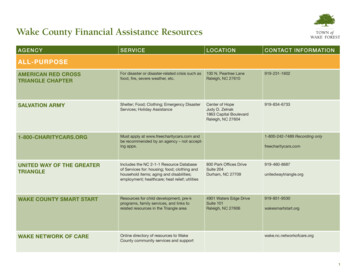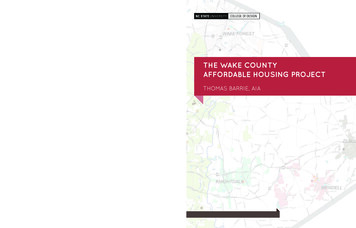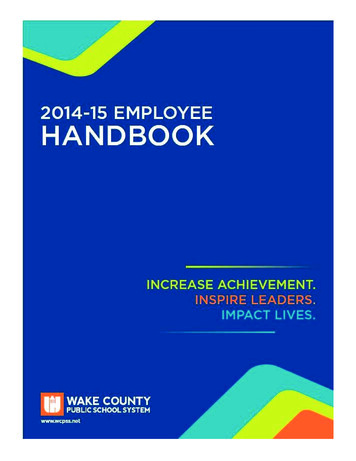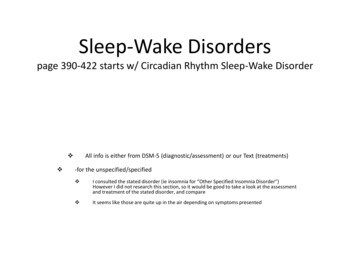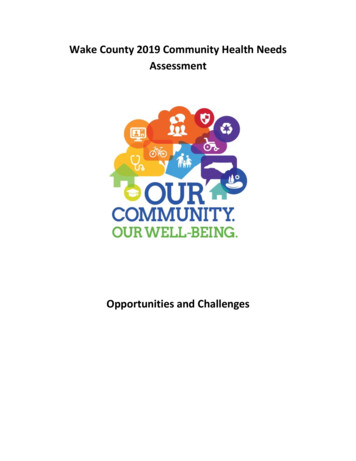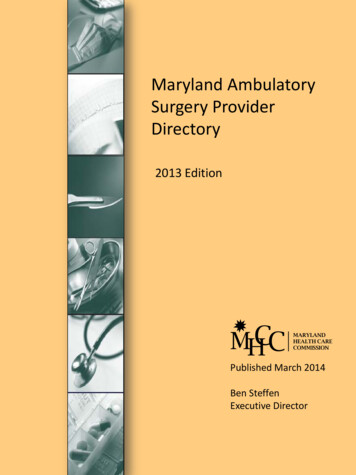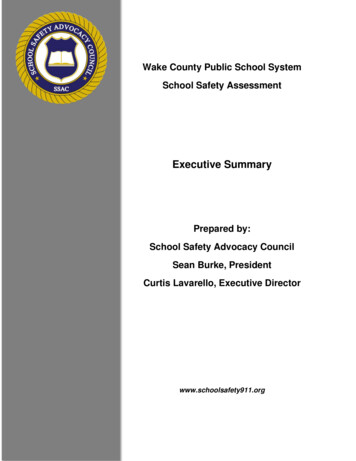
Transcription
Wake County Public School SystemSchool Safety AssessmentExecutive SummaryPrepared by:School Safety Advocacy CouncilSean Burke, PresidentCurtis Lavarello, Executive Directorwww.schoolsafety911.org
Wake County Public School SystemSchool Safety AssessmentExecutive SummaryThis Executive Summary is being provided to the Wake County Public SchoolsSystem as part of the Comprehensive School Safety Assessment.Page 2
Wake County Public School SystemSchool Safety AssessmentExecutive SummaryCAVEATRecommendations in this Executive Summary reflect the School Safety AdvocacyCouncil understanding of the state of security at the Wake County Public School Systemat the time of our initiative. We recognize that security, safety, emergency managementand crime prevention/reduction strategies are dynamic processes. As the Districtfunctions or activities change or facility conditions are modified or expanded, some of theassumptions made during this review process will also change. Therefore, securityprocess management, technology, policies and procedures should be routinely reviewedand updated to reflect changes in the environment and the expectations of thecommunity.Although we believe the recommendations contained in this Executive Summary arereasonable and appropriate, the School Safety Advocacy Council cannot provide legalguidance or advice. Therefore, we recommend that legal counsel be sought, if indicated,before policies or programs are changed or implemented.Page 3
Wake County Public School SystemSchool Safety AssessmentExecutive SummaryINTRODUCTIONThe goal of this report is to synthesize the information gathered from the Wake CountyPublic School System during the Comprehensive School Safety Assessment. As a resultof the information collected, The School Safety Advocacy Council developed an expertopinion about the key challenges associated with keeping the District safe. The SchoolSafety Advocacy Council examined all the available evidence on current District safetymeasures and procedures, and is proud to present an expert view of the needs and limitsof current safety solutions and other safety practices.The Wake County Public School System should be commended for understanding that acomprehensive district-wide evaluation should be conducted before implementing orpurchasing any school safety improvements. When considering which school safety andsecurity recommendations to select, it is important for the administration to use all theavailable information to justify and document the decision. With the intent to provide thePublic School System with as much information as possible, this evaluation drew fromseveral approaches, staff interviews, staff focus groups, school safety assessments,document and MOU reviews, and the state mandated climate survey reports.Decisions about whether to invest in school security improvements for the Wake CountyPublic School System are complex and must consider a variety of logistical, economic,and political factors. Security improvements, such as those referenced in this report,provide numerous solutions that the school system can adopt to enhance student, visitor,and staff safety. Although security measures are often crisis-driven, the public schoolsystem should consider the following items before acquiring and implementing the safetyimprovements: A positive school climate is crucial to fostering learning; security should not create aprison-like atmosphere or generate additional fears. Policy cannot compensate for inherent building design weaknesses. Without training, school safety improvements can be ineffective. Without the appropriate culture, school safety measures can be jeopardized orineffective. School safety improvement should focus on addressing a specified problem.It must be understood that full implementation of the recommendations included in thisreport cannot guarantee that Wake County’s campuses or the surrounding areas will becrime-free or totally safe without threats. Rather, this document is meant to assist inreducing the potential for incidents by providing a “roadmap” for enhancing theeffectiveness of security resources by improving training and staff awareness of potentialproblems and further implementing security improvements. However, thePage 4
Wake County Public School SystemSchool Safety AssessmentExecutive SummarySchool Advocacy Council believes that security equipment is only one part of the WakeCounty Public School System total security “system.”Additional components of the overall security strategy must include the application ofexisting policies, procedures and processes, the selection, recruitment and retention oftrained staff, proper staff supervision, communication and collaboration with theadministration and other stakeholders, proactive law enforcement participation andcommunity involvement.Page 5
Wake County Public School SystemSchool Safety AssessmentExecutive SummaryABOUT THE SCHOOL SAFETY ADVOCACY COUNCILThe School Safety Advocacy Council (SSAC) was established with the goal of providingthe highest quality school safety training and services to school districts, law enforcementagencies and communities. The Council strives to expand beyond a singular approach ofrelying on law enforcement as the only solution to school violence and transition to acooperative approach which includes all of the educational stakeholders.With Curtis Lavarello as the Executive Director and Sean Burke as the President, theSchool Safety Advocacy Council has become the recognized leader in school safetyservices and training. The Council is currently the host of the largest conference in thenation addressing all aspects of school safety, the National School Safety Conference,as well as the National Conference on Active School Threats, both conferences drawprofessionals in their respective fields from all over the world. The Council also hosts theNational Executive Leadership Academy on School Safety, which is attended bymanagement- level professionals from education and law enforcement from across thenation.In addition to the national conferences, the School Safety Advocacy Council has workedin cooperation with the U.S. Department of Justice, National Institute of Justice and itscenters, the Justice Technology Information Center and the Small Rural Tribal BoarderCenter, to provide training and services to school districts and law enforcement agenciesnationwide. In an effort to provide the most accurate and up-to-date information toeducation and law enforcement, SSAC works to develop technology and initiatives withthe U.S. Department of Justice and its centers on addressing current school safety needs.The School Safety Advocacy Council also prides itself on its partnership with the FederalBureau of Investigation (FBI) and the FBINAA (Federal Bureau of Investigation NationalAcademy Associates).Page 6
Wake County Public School SystemSchool Safety AssessmentExecutive SummaryPROJECT OVERVIEWThe Wake County Comprehensive School Safety Assessment Initiative was divided intothree phases: Information Collection, Recommendation and Implementation, and Reviewand Presentation. These phases guided the process and ensured the effectiveachievement of the goals set forth in the scope of work.Phase1: Information CollectionThis was the most important phase of the project and is the cornerstone for allrecommendations or actions going forward. It was imperative to be as thorough in allinformation-gathering efforts so that as many stakeholders as possible were involved inthe process.For the purpose of this project, the School Safety Advocacy Council was not solelyattempting to collect negative opinions or safety areas in need of improvement, but alsomaking a concerted effort to identify the positive efforts and initiatives the District hasimplemented. In any accurate assessment of school safety, it is just as important torecognize the positive efforts as it is the negative ones in an attempt to improve.Phase2: Recommendations and ImplementationIn this phase of the project, all the collected information was synthesized, reports anddeliverables were completed and submitted to the district. Reports detailing theinformation collected of positive school safety initiatives and opportunities to strengthensafety and security were created and sub-divided by department and/or initiative. Thisformat allows the team to meet with any department or individual necessary to discussthe findings and recommendations.Phase 3: Review and PresentationIn this phase, all of the individual reports, findings, recommendations, policies andprocedures, deliverables, and evaluation components were combined into a singlecomprehensive report on the initiative. This report is reflective of and provides a pathwayto accomplish the strategic goals of the Wake County Public School System. Acomprehensive final report was presented and discussed with the Wake County SchoolDistrict Administrative Team.Page 7
Wake County Public School SystemSchool Safety AssessmentExecutive SummaryEXECUTIVE SUMMARY OF FINDINGSDistrict Staff Assistance During the Assessment ProcessUpon our team being notified by the Wake County Public School System that our teamhad been selected for this highly technical initiative we were immediately contacted bythe Wake County Office of Safety and Security Director Russ Smith. Mr. Russ Smithserved as our team’s point of contact throughout the entire assessment process. Ourteam applauds the assistance provided by Mr. Smith and his Leadership Team, who werethere for us from the beginning until the end of this project. Unlike other School District’swe have worked with, Wake County Public School District Leaders made no attempt torestrict our focus of the safety assessment process. From the onset of this process, WakeCounty School District Leadership remained extremely helpful and focused on theprotection of students and staff.SCHOOL SAFETY ASSESSMENTSThe School Safety Advocacy Council completed several school safety assessments anddeveloped a data-driven justification for matching a problem to a potential solution(s). Theobjective of a school safety assessment is to gather, analyze, and communicateinformation about threats, likelihood, assets, vulnerabilities, and consequences in a waythat allows school officials to decide what actions to take. Actions are intended to createa level of protection that reduces the vulnerabilities to threats and their potentialconsequences, thereby reducing risk.A school safety assessment is useful in determining the potential impacts of threats andhazards to the assets in an individual school, or across a district. The school safetyassessment can provide the foundation and justification for identifying and prioritizingactions, including modification to existing safety and security initiatives. No matter themethod used, the end result should be a prioritized list of security improvements for theschool district. District leadership should review their identified needs and assignprioritization, keeping in mind limits imposed by Federal, State, local and schoolmandates, political and parental concerns, and, lastly, local law enforcement and firedepartments are advised as appropriate.Page 8
Wake County Public School SystemSchool Safety AssessmentExecutive SummaryDistrict-wide Staff SurveysAs part of this comprehensive district-wide assessment process, the School SafetyAdvocacy Council conducted an anonymous staff safety survey to assist our team ingaining valuable insight into both existing safety strengths and perceived and actualopportunities for improvement within the school system.As a result of this, every school administrator was sent a link for both their instructionalstaff, as well as their support staff to take the survey. Some of the key findings of thissurvey were: 76% of those completing the survey were classroom teachers48% were from Elementary Schools, 28% from Middle Schools and 22% fromElementary Schools46% of those surveyed had over 5 years’ experience. 27% had 1-3 years’experience, 18% had 4-5 years and 9% newly hired.When surveyed if the employee currently feels safe within their school, 90%indicated Yes.When surveyed if the employee felt they were well trained and prepared handle acritical incident at their school, 78% stated Yes, while 15% stated No, and theremainder did not respond.72% of those surveyed stated they had read and were familiar with their school’scrisis plan. 22% stated they were not.94% of those surveyed stated they have taken part in their school’s lockdowndrills. 6% stated they had not.18% of those surveyed stated they had taken part in table-top school relatedsafety training. 45% stated they had not, and 37% stated they were unsure. Thiswas an identified concerned relayed to district staff in the final report.When asked if there was a specific area that could be at risk for student and/orstaff safety, 44% stated Yes. Examples of areas of focus are highlighted Trainingand Visitor ManagementPage 9
Wake County Public School SystemSchool Safety AssessmentExecutive SummaryDuring the assessment process, examples of areas of focus and highlighted as: Training received Parents on campus Staffing levels. Drill timing.Page 10
Wake County Public School SystemSchool Safety AssessmentExecutive SummaryPurpose of Executive Summary and LimitationsThis executive summary outlines the scope of work that was performed by the SchoolSafety Advocacy Council. A full district-wide assessment report, as well as individualschool assessment reports were provided to school-district leadership.Thatcomprehensive report outlines many areas that the district is already performingextremely well in the area of safety and security. The report also outlines areas of safetyand security that can be enhanced and improved. Many of the areas identified asopportunities for improvement are purposely left out of this executive summary as to notalert potential perpetrators to an area of risk.As part of this comprehensive assessment process, there were several areas thatour team identified as opportunities for enhancement as it relates to safety andsecurity. Specific recommendations for each of these areas were highlighted inthe full district-wide security report provided to the district. It should also be notedthat not all areas identified as having opportunities for enhancement, wereincluded in this summary. This was intentional and based upon national bestpractices as they related to security assessments and sensitive information.The areas identified in the main report were: School Resource Officer (SRO) ProgramDuring the assessment process, our team members continually received praiseand support for the district’s School Resource Officer Program. However, due tothe fact that there were several law enforcement agencies participating in this, theselection, training and supervision of the SRO’s was not always consistent, andour team felt it could be improved upon. A district-wide School Resource OfficerOperations Committee was recommended. Review of off campus lunch / dining policyDuring the assessment process, the assessment team members noted that manyhigh schools have an off-campus dining / lunch policy.Page 11
Wake County Public School SystemSchool Safety AssessmentExecutive SummaryWhile the School Safety Advocacy Council does recommend that all schoolsmaintain a closed campus policy for high schools, the Wake County School Districtwould be best served to explore this policy in the future with key district staff, theWake County School Board, and the broader community. District-wide Emergency Communications and Mass NotificationSeveral opportunities for added Emergency Communication were identified in thefinal report. A district-wide communications center should be prioritized as thedistrict moves forward.Page 12
Wake County Public School SystemSchool Safety AssessmentExecutive Summary District-wide Visitor Management protocolThe district should continue to prioritize a district-wide standardized visitormanagement system. Campus SignageThroughout the districtwide assessment process, our team noted that manyschools lacked proper signage which can assist in the overall school safetyprotocol. Many schools lacked the basic signage directing visitors to the properparking areas and/or the main entrance of most schools. Additionally, our teammade note that many schools lacked “no trespassing” signs, or signs indicating theuse of video surveillance cameras. A number of recommendations were madedistrict-wide in this area, but additionally, recommendations were made for eachindividual site as well. District-wide Staff Development Training in the Safety and Security fieldSeveral opportunities to add to the overall school safety related training districtwide were identified in the final report. Wake County Public School System shoulddevelop and implement a professional development program focused on buildingemployee capacity in the area of school safety and emergency management. Aprofessional development program delivered online and/or in person, with contentdeveloped by subject-matter experts, will support and enhance the capacity of theschool district and its schools to provide a safe and orderly learning environmentfor students.Page 13
Wake County Public School SystemSchool Safety AssessmentExecutive Summary Volunteer Screening and ProtocolIt is the recommendation of SSAC that any volunteer undergo a criminal recordsand sexual predator check per WCPSS Board of Education Policy. District-wide Threat Assessment TeamWake County Public Schools should establish a threat assessment policy andteam within the district. The threat assessment process is centered upon ananalysis of the facts and the evidence of behavior of each situation. School Security DepartmentAs part of the school safety assessment program, the school district securitydepartment was evaluated. The security department, headed by Senior DirectorRuss Smith, consistently received positive feedback during school staff interviews.The positive opinion of the security department was also reaffirmed in the schoolsafety survey conducted as part of the assessment process. The survey found that90% of school-based staff responding felt safe in their school, which reflectspositively on the efforts and work of the security department. During the evaluationthe team was impressed by the quality and quantity of work the securitydepartment does with minimal staff. The minimal staffing of the securitydepartment is the basis for most of the recommendations below.As a result of our evaluation of the security department, we recommend thefollowing. Increase the number of security administrators to nine to reflect the currentdistrict breakdown and area superintendents’ assignments. This would decreasethe number of schools each security administrator would have to service, thusincreasing the attention they can provide to their assigned schools. Establish a dedicated position for a physical security specialist that would workin cooperation with school principals to improve physical security at each school.While conducting school-based interviews numerous principals of newer schoolsrelated to our team that they would have liked to have more input on the securityfeatures of the new buildings. This position would consult on new school buildingdesigns and systems, such as surveillance upgrades, and be able to provide theprincipals point of view to the process. Establish the position of Emergency Manager, who under the direction of theSenior Director of Security, will be the district leader and expert in disaster,security, and emergency planning for school sites and administration offices. ThisPage 14
Wake County Public School SystemSchool Safety AssessmentExecutive Summaryposition will be responsible for complying with increasing state mandates, whiledirecting the coordination, development, and promotion of emergency serviceoperations procedures, and best practices. The position will coordinate emergencymanagement programs and activities associated with preparation for, response to,and recovery from natural or manmade disasters or emergencies. Establish a security training division to plan, direct, and coordinate security andemergency management educational programs to enhance the knowledge andskills of the district’s employees. The division would be responsible for creating orselecting course content and materials for security and emergency managementtraining programs. Training may be in the form of a video, self-guided instructionalmanual, or online application and delivered in-person or through a computer,tablet, or other hand-held electronic device. The division must ensure that trainingmethods, content, software, systems, and equipment are appropriate andmeaningful.In place of hiring employees to staff this division, the district may contract theservices out to a qualified provider. If staff chooses to proceed with a contractedprovider, they should have knowledge of both the district’s security and emergencymanagement policies and procedures as well as national best practices.CONCLUSIONThe School Safety Advocacy Council strongly feels that as a result of the findings of thisreport, the leadership of the Wake County Public School System cares deeply about thesafety of district students and staff. We are confident that that District leadership willcontinue to focus time, funding, and resources in improving school safety. Along with thisfocus, District leaders need to implement less tangible items such as standardization andprofessional development. It is not sufficient to simply develop policies or providetrainings. It is critical to follow-through to confirm that policies are enforced, that trainingswere understood and that information was applied.The culture of school safety is set each day by the adults on campus. In other words,students will rise to the high expectations of adults or misbehave when low expectationsare established. The challenge is that in the absence of shared high expectations by alladults, low expectations are allowed to spread. All administrators, teachers, and site staffmust be empowered to take responsibility for the safety of their campus and must beshown how they are an integral part of making their schools safe.Page 15
the Wake County Office of Safety and Security Director Russ Smith. Mr. Russ Smith served as our team's point of contact throughout the entire assessment process. Our team applauds the assistance provided by Mr. Smith and his Leadership Team, who were there for us from the beginning until the end of this project. Unlike other School District's

